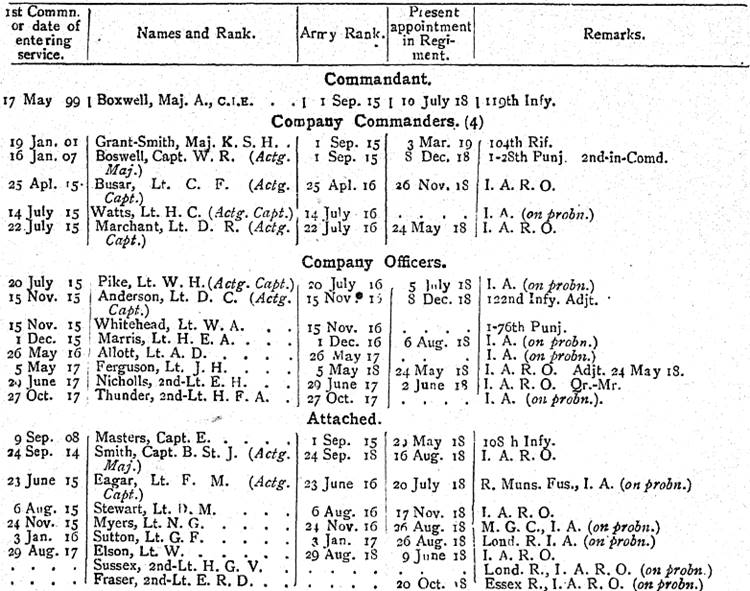This article is about the 2nd Battalion 154th Indian Infantry and will help you to research both the Battalion and soldiers who served with it. I have written separate articles for the 1st and 3rd Battalions and a series of guides to help you research soldiers who served in the Indian Army during the First World War:
- 1st Battalion 154th Indian Infantry
- 3rd Battalion 154th Indian Infantry
- Guides to Researching Soldiers who Served in the Indian Army
The 2nd Battalion 154th Indian Infantry
Lineage: Formed at Basra, Mesopotamia (Iraq) on 20 May 1918 and disbanded on 15 May 1921.
Class Composition of Battalion in 1919: 3 1/2 Companies of Gujars, and 1/2 a Company Rajput Musalmans.
The 2nd Battalion 154th Indian Infantry was formed at Basra, Mesopotamia on 20 May 1918. The Battalion was one of eighteen new Indian infantry battalions formed in the field in 1918 to replace British battalions departing the Middle East for the Western Front. This was in consequence of the German Spring Offensive which began in March 1918. The 2nd Battalion 154th Indian Infantry was formed of drafts from the following Indian regiments:
- 102nd King Edward’s Own Grenadiers
- 108th Infantry
- 119th Infantry (The Mooltan) Regiment
- 122nd Rajputana Infantry
The Battalion moved to Egypt in July 1918 where it joined the 233rd Infantry Brigade 75th Division. The Battalion took part in the last stages of the Palestine Campaign including the Battle of Megiddo in September 1918. The Battalion returned to Egypt after the war and was disbanded on 15 May 1921.
Below is an extract from the April 1919 Indian Army List recording the British officers serving with the 2nd Battalion 154th Indian Infantry. Indian Army Lists are great resources to use to research both units and officers of the Indian Army. They are full of military jargon so I have written a guide to help you: Indian Army Abbreviations and Acronyms.
War Diary of the 2nd Battalion 154th Indian Infantry
There is only one war diary for the 2nd Battalion 154th Indian Infantry which can only be viewed at the National Archives. I have transcribed some entries from the war diary at the bottom of the page.
- Date: 24 May 1918 – 28 February 1919
- 233rd Infantry Brigade 75th Division, Egyptian Expeditionary Force
- Reference: WO 95/4691
- Notes: A good, detailed war diary which lists British officers who were with the Battalion when it was raised. July 1918 gives a list of appointments made in the Regiment (British and Indian officers, and Indian other ranks). British and Indian officers and Indian other ranks (with service number) appear throughout.
Further Sources for the 2nd Battalion 154th Indian Infantry
If you would like to learn more about a British or Indian officer who served with the 2nd Battalion 154th Indian Infantry, then the Indian Army List can be consulted. No regimental history was produced for the 154th Indian Infantry and there are no confidential reports for the 2nd Battalion.
Extracts from the War Diary of the 2nd Battalion 154th Indian
24 May 1918 – 28 February 1919, Egyptian Expeditionary Force, WO 95/4691
24 May 1918 – Makina Camp – Four companies one from each of the following regiments, 102nd Grenadiers, 108th Infantry, 119th Infantry and 122nd Rajputana Infantry, having assembled at Makina Camp, Basrah. The 2nd Battalion, 154th Indian Infantry was formed.
May 1918 – During the above periods parades under Company Commanders were carried out for three hours daily. A route march or battalion parade under the Commanding Officer took place every third day. Clothing and personal equipment to complete were drawn from the Battalion. No mobilisation equipment was drawn, as this was to be issued in Egypt.
20 June 1918 – The detachment embarked on H.T. Rembrandt on the morning of the 20th, with the whole of the 1st Battalion 153rd Indian Infantry, making a total of more than 1300 Indian Other Ranks onboard. These troops were transhipped at Fao ? on the night of 20 to the H.T. Hong Moh. The transhipment took a considerable and was carried out under difficult conditions.
There was only one very narrow and sloping gangway, all heavy kit has to be manhandled from one ship to the other, and here was no illumination of any kind. The accommodation on the decks and troop decks was very limited for the number of men occupying them. The men were entirely crowded and the ventilation of the troop decks was very bad…
June 1918 – During the period 1 – 18 inclusive, the usual battalion and company parades were carried out daily. Owing to the lack of Lewis guns, signalling equipment etc. no specialist training could be undertaken. The health of the battalion during the month was good.
07 July 1918 – Suez Canal – Special sanction being obtained, all ranks were able to bathe and wash their clothes in the Suez Canal between 4-6 am.
10 August 1918 – Fighting scale for Infantry of 75 Division laid down as: Dress: Khaki (service dress or drill as ordered) jacket and shorts, puttees, steel helmet, with shirt drawers, socks and boots. Equipment (a) Rifle and bayonet and 120 rounds small arm ammunition except in case of specialists armed with rifles who only carry 50 rounds. (b) webbing or leather equipment with entrenching tool and pack. The latter to contain the following articles:-
1 Mobile [?] Ration… 1 Iron Ration. 1 Pair Socks. 1 Cardigan. 1 Cap Comforter. 1 Holdall (containing washing and shaving kit, knife, fork and spoon. 1 Towel. 1 Mess Tin (Indian units cavalry pattern). 2 Sandbags (if ordered). c) Haversack containing pipe, tobacco, cigarettes and housewife. d) Glasses or range finder where available. e) Small box respirator.

